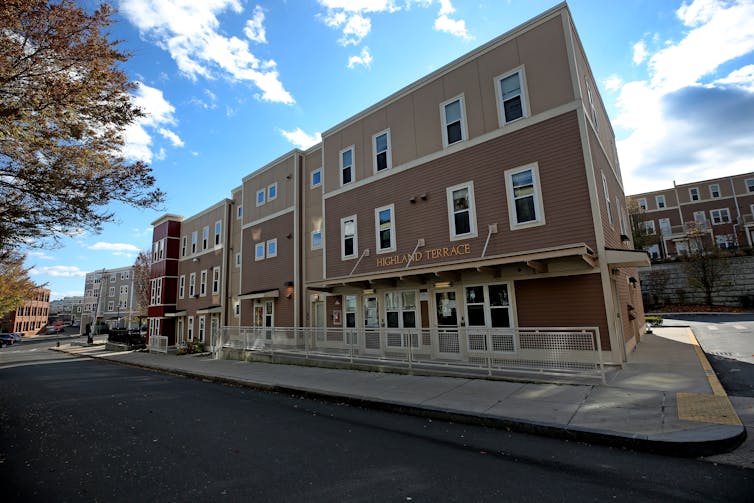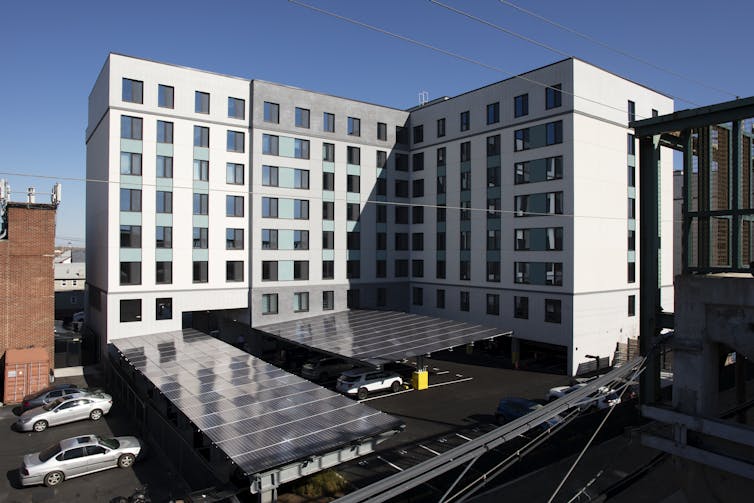Using green banks to solve America’s affordable housing crisis – and climate change at the same time
Using green banks to solve America's affordable housing crisis – and climate change at the same time The Conversation


Green Banks: A Path to Sustainable Housing
Green banks are gaining attention in the United States, especially since the federal government recently announced its first grant competitions under a national green bank program aimed at bringing clean technology and affordable energy to low-income communities.
While most green banks focus on clean energy, Massachusetts is launching an innovative new green bank that specifically aims to increase the state’s stock of sustainable and affordable housing. This initiative comes at a crucial time, as states now have access to billions of dollars in new federal funding for green banks through the Inflation Reduction Act.
What is a Green Bank?
Contrary to their name, green banks are not traditional banks. They function more like investment funds with a mission to promote sustainability. Green banks are public, quasi-public, or nonprofit entities that use public funds to encourage private investment in low-carbon, climate-resilient infrastructure. By utilizing innovative financing strategies, green banks can reduce the risks for private investors and lower the amount of public money needed to achieve government goals, such as expanding renewable energy or promoting affordable housing.
Green Banks Across the US
The United States currently has around two dozen green banks operating in at least 18 states and the District of Columbia. Most of these banks focus on accelerating the transition from fossil fuel use to clean energy. In 2022 alone, these banks mobilized $3.12 billion in private investment using $1.51 billion of public money. Since 2011, they have brought in a total of $14.8 billion.
Each green bank is slightly different. Connecticut’s green bank was the first state-run green bank in the US and initially focused on renewable energy but later expanded to include other sustainable infrastructure projects. Michigan created a nonprofit green bank called Michigan Saves, which provides financing for energy efficiency. Hawaii’s state-run green bank focuses on boosting solar energy use. At the local level, Maryland’s Montgomery County has been financing various sustainable projects through a green bank since 2016.
A Green Bank for Sustainable Housing
The newly established Massachusetts Community Climate Bank is dedicated to climate-friendly and resilient affordable housing, aligning with the state’s Climate Plan for 2050. This initiative aims to upgrade existing housing complexes with energy-efficient features, transition to electric household appliances, and incorporate solar panels and electric vehicle chargers. Residential buildings are one of Massachusetts’ largest sources of greenhouse gas emissions, accounting for 19% of the total. Making housing more sustainable would not only reduce emissions but also have a positive impact on other sectors, such as reducing the demand for electricity from natural gas-fired power plants.

One of the challenges in financing sustainable housing is that the finance industry often views new technology and low-income households as risky investments. Green banks can help “de-risk” these investments by using public money to provide low-rate loans to private or local lenders on the condition that they lend money at affordable rates for customers to adopt sustainable practices. Other financial instruments, such as loan guarantees and co-investment, can also be utilized by green banks.
The Massachusetts green bank started with an initial $50 million in state funds and aims to attract private investors and federal funding to further expand its operations. The timing is strategic, as the Inflation Reduction Act includes funding for green banks, including a $27 billion Greenhouse Gas Reduction Fund, $20 billion of which is earmarked for nonprofits to invest indirectly in green projects through local financing entities like green banks.
Lessons from Green Banks Around the World
Researchers at Tufts University’s Climate Policy Lab have studied green banks worldwide and have identified several foundational principles that can help increase financing for climate priorities while maintaining financial viability and avoiding excessive housing debt. These principles include having a clear mission, being profit-making but not profit-maximizing, addressing market gaps rather than competing with private investment, utilizing various financial instruments, and having an independent and stable governance structure.
The Massachusetts green bank already has a sector-focused mission that targets a market gap. However, it could further clarify its focus on affordable housing by aligning it with the state’s definition of disadvantaged communities. For example, the New York Green Bank aims to invest 35% of its total funds in green housing projects that benefit disadvantaged communities by 2025.

In addition to reducing greenhouse gas emissions, green banks can also prioritize climate resilience. This can include funding projects such as adding green spaces around buildings for natural cooling. Affordable housing in the US is often located in highly vulnerable areas, such as flood-prone regions. Green banks can support initiatives like Connecticut’s Property Assessed Resilience, which allows homeowners to borrow for flood protection upgrades and repay the loans over time through modest increases in their property tax bills.
By focusing on the scarcity of affordable housing, green banks can simultaneously reduce emissions and socioeconomic inequity. This integrated approach represents a significant opportunity for effective climate policy.
SDGs, Targets, and Indicators
SDGs Addressed or Connected to the Issues Highlighted in the Article:
- SDG 7: Affordable and Clean Energy
- SDG 11: Sustainable Cities and Communities
- SDG 13: Climate Action
Specific Targets Under Those SDGs Based on the Article’s Content:
- SDG 7.2: Increase substantially the share of renewable energy in the global energy mix
- SDG 11.1: By 2030, ensure access for all to adequate, safe, and affordable housing and basic services and upgrade slums
- SDG 13.2: Integrate climate change measures into national policies, strategies, and planning
Indicators Mentioned or Implied in the Article:
- Investment mobilized by green banks
- Total greenhouse gas emissions from residential buildings
- Number of affordable housing units with upgraded insulation, windows, and sustainable energy systems
- Amount of public funds allocated to green banks
- Amount of private investment attracted by green banks
Table: SDGs, Targets, and Indicators
| SDGs | Targets | Indicators |
|---|---|---|
| SDG 7: Affordable and Clean Energy | Increase substantially the share of renewable energy in the global energy mix (Target 7.2) | Investment mobilized by green banks |
| SDG 11: Sustainable Cities and Communities | By 2030, ensure access for all to adequate, safe, and affordable housing and basic services and upgrade slums (Target 11.1) | Total greenhouse gas emissions from residential buildings Number of affordable housing units with upgraded insulation, windows, and sustainable energy systems |
| SDG 13: Climate Action | Integrate climate change measures into national policies, strategies, and planning (Target 13.2) | Amount of public funds allocated to green banks Amount of private investment attracted by green banks |
Explanation:
– The article discusses the role of green banks in promoting renewable energy, affordable housing, and climate action, which align with SDGs 7, 11, and 13.
– The specific targets identified from the article’s content are Target 7.2 (increasing the share of renewable energy), Target 11.1 (ensuring access to adequate and affordable housing), and Target 13.2 (integrating climate change measures into policies).
– The indicators mentioned or implied in the article include investment mobilized by green banks (related to renewable energy), total greenhouse gas emissions from residential buildings (related to housing sustainability), and the amount of public funds and private investment attracted by green banks (related to climate action).
Behold! This splendid article springs forth from the wellspring of knowledge, shaped by a wondrous proprietary AI technology that delved into a vast ocean of data, illuminating the path towards the Sustainable Development Goals. Remember that all rights are reserved by SDG Investors LLC, empowering us to champion progress together.
Source: theconversation.com

Join us, as fellow seekers of change, on a transformative journey at https://sdgtalks.ai/welcome, where you can become a member and actively contribute to shaping a brighter future.







